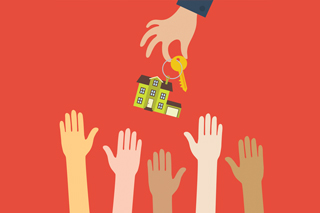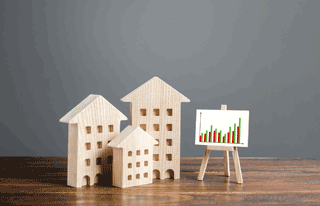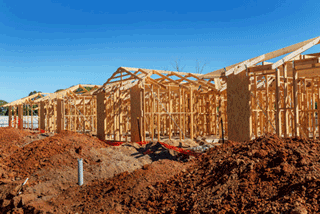Quote Of The Week
“The housing shortage is a worsening crisis that is affecting Australians who are already highly vulnerable. At the most basic level it starts with disadvantaged first home buyers pushing up the prices of the private rental market and forcing those on lower incomes into social housing and, in extreme cases, homelessness.”
Real Estate Buyers Agents Association president Cate Bakos
Migrants Boost Population Growth
 Overseas migrants are finally starting to return with new figures showing 110,000 people moved to Australia in the 12 months to March.
Overseas migrants are finally starting to return with new figures showing 110,000 people moved to Australia in the 12 months to March.
Australian Bureau of Statistics show migrant levels remain half of what they were before the start of the Covid pandemic when net overseas migration figures ranged between 238,000 and 260,000.
In addition to overseas migrants, a similar number of Australians were added to the population through natural growth. In the past 12 months there were 309,300 births and 179,100 deaths.
Beidar Cho, Demography Director at the ABS, says after two years of mostly low or no population growth, overseas migration is again a significant contributor to Australia’s population increase.
The ABS figures show a large number of international students have started to return to Australia.
Queensland’s population grew by the largest number of people in the past year, up by 94,300 people, followed by New South Wales, 49,500, Victoria, 46,500, and then South Australia, 13,980.
Housing Shortage Tipped To Worsen
 The Federal Government’s housing agency warns the housing shortage could soon become worse, as supply remains low and overseas migration levels pick up.
The Federal Government’s housing agency warns the housing shortage could soon become worse, as supply remains low and overseas migration levels pick up.
National Housing Finance and Investment Corporation chief executive Nathan Dal Bon says supply will remain low as housing construction levels are dropping because of delays and shortages in the system.
“With supply expected to come off earlier than expected, coupled with stronger population growth (with migration rising), we could see a larger supply gap emerge over the next few years,” Dal Bon says.
He says buyers keen to get into the market and out of renting have used the Federal Government’s First Home Loan Deposit Scheme, in which qualified buyers only require a deposit between 2% and 5% to buy, with the remaining deposit guaranteed by the Government.
FHBs in Queensland and WA applied for the largest number of places in the scheme while lower numbers from NSW and Victoria could be attributed to prices often being above the scheme’s threshold.
House-Unit Price Gap Narrows
 The difference between the price of houses and units is beginning to narrow despite solid house price growth in the past 18 months.
The difference between the price of houses and units is beginning to narrow despite solid house price growth in the past 18 months.
Demand for larger properties during Covid helped to generate significant house price rises, creating a bigger difference in values of the different types of properties.
With house prices now beginning to soften in many locations, that price differential has eased, particularly as unit prices appear to be holding firm.
PropTrack’s Home Price Index shows the national average house price has fallen by 3.6% since March, while during the same period unit prices on average have fallen only 2.6%.
Its analysis of 88 statistical regions in Australia show house values fell in 71 regions while only 43 regions experienced falls in unit values.
Sydney’s Northern Beaches region tops the list for the largest price fall across both houses and units, with house prices down 10.6% and unit prices down 9.8% from their peaks in October last year.
Crane Numbers Rise To Record 868
 Builders may be struggling with staff and materials shortages, but a new report shows there are a record 868 cranes operating across Australia’s skyline.
Builders may be struggling with staff and materials shortages, but a new report shows there are a record 868 cranes operating across Australia’s skyline.
The latest RLB Crane Index shows tower cranes used in high-rise apartment projects increased to 535 and cranes on commercial projects rose to a record 333.
Sydney has the largest number of cranes in operation with 380 working across the region, while Melbourne has 206 and Brisbane 82.
RLB Oceania’s Domenic Schiafone says it shows the continuing resilience of the industry.
Schiafone says the numbers are also high as a result of delays in construction from weather events, shortages of materials and lack of skilled labour.
That, according to Schiafone, can result in major cost issues for builders and developers.
“If cranes providing logistical assistance to multi-storey developments remain on site longer than anticipated due to weather events and supply chain disruptions, the cost of preliminaries increase, causing overall costs to rise.”
Perfect Storm Causes Home Builds To Fall
 Construction of new homes is expected to ease in the next two years, according to Master Builders Australia.
Construction of new homes is expected to ease in the next two years, according to Master Builders Australia.
Its five-year projection shows it is likely to drop below the 200,000 annual houses and apartments required to keep up with population growth, which will put further upward pressure on property prices.
MBA chief executive Denita Wawn says the next two years are not “looking good” for home supply, as a result of inflation, building material delays, worker shortages and red tape.
New home builds have already blown out from nine months to 12 months.
The report predicts dwelling starts in 2024 will fall to 174,930.
“We know that to meet the housing needs of Australians, even with a slight downturn in migration, we’re going to need to build about 200,000 homes per year to maintain demand,” Wawn says.
“Our concern at the moment and our focus in discussions with governments is around how we stimulate house building to meet those population needs.”




